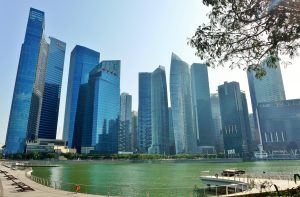JLL’s latest Global Real Estate Transparency Index shows Asia Pacific real estate transparency makes largest gains globally
Asia Pacific’s emerging markets have made the most significant gains in improving real estate transparency, led by a greater emphasis on corporate social responsibility and wider adoption of new technologies. According to JLL’s biennial Global Real Estate Transparency Index, Southeast Asian countries like Thailand, Vietnam, Philippines and Indonesia are among the global top 10 improvers, while Singapore continues to feature prominently as a transparent market.
The 2020 Index is launched at a time of massive economic and societal disruption where the need for transparent processes, accurate and timely data and high ethical standards are in closer focus. The backdrop of COVID-19 is also ensuring that transparency within Asia Pacific’s real estate legal and regulatory systems is more important than ever to global investors, as they look to deploy approximately $40 billion* in dry powder capital into the region.
Asia Pacific real estate transparency improves as investors look for class assets

According to JLL, pressure exists from investors, businesses and consumers to further improve real estate transparency to compete with other asset classes and meet heightened expectations about the industry’s role in providing a sustainable and resilient built environment in the age of COVID-19. Furthermore, innovative new property technology (proptech) is changing how real estate data is gathered and analyzed and influencing industry transparency at a regulatory level.
“While investment into commercial real estate has inevitably paused during the pandemic, the overarching trend toward rising allocations to this asset class will continue. As investors look to allocate more capital into real estate in this region, transparency becomes even more important, as will the enforcement of robust regulatory frameworks,” says Regina Lim, Head of Capital Markets Research, Asia Pacific, JLL.
Emerging markets have once again shown the greatest advancement in the Index, with six Asia Pacific markets – Mainland China (32nd), Thailand (33rd), India (34th), Indonesia (40th), Philippines (44th) and Vietnam (56th) – among the top 10 biggest improvers globally. Progress in Thailand’s and Vietnam’s main cities, Bangkok and Ho Chi Minh City, has pushed each into a higher tier – ‘Transparent’ and ‘Semi-Transparent’ respectively. Singapore (14th) sits near the cusp of the ‘Highly Transparent’ tier as it has risen one spot from number 15 in 2018.
Singapore among top ten in Asia Pacific real estate transparency
Table of Contents
“Singapore has come in within the top 10 for the quality and depth of its market data, reflecting the maturity of its real estate sector,” says Chris Fossick, CEO, JLL Southeast Asia. “Singapore has consistently ranked well on the transparency tier among Asia’s mature economies and it has made great progress over the past couple of years due to its strengths as a regional hub for proptech companies and government leadership on sustainability initiatives.”
In both Asia Pacific and outside of the region, JLL’s research concludes that sustainability commitments have become the biggest single driver of real estate transparency globally since 2018. An increased focus on corporate social responsibility and acknowledgement of the need to create sustainable buildings bring environment, social and governance (ESG) considerations into the mainstream. Additionally, green building certification systems and energy efficiency standards are widespread in the region’s most transparent markets and the most improved national real estate sectors.
Another key driver of transparency is the volume of real estate market data now available due to the growing adoption of Proptech platforms, digital tools and “big data” techniques. Although real estate markets have historically faced challenges when implementing new technology, the COVID-19 pandemic is leading to an acceleration in new types of non-standard and high-frequency data – especially relating to health, mobility and space usage – being collected and disseminated in near-real-time.
“As the adoption of proptech and sustainability commitments continue to garner steam, greater transparency gains will be driven by both an evolving regulatory landscape and the collective actions by national real estate industries. With the outbreak of COVID-19, it will become even more crucial for the real estate industry to work collaboratively with local governments to achieve greater transparency and meet the changing expectations of investors as their appetites shift in accordance to the investment outlook over the next 12 to 18 months,” adds Fossick.
JLL and LaSalle have been tracking real estate transparency and championing higher standards since 1999. This 11th edition of the Global Real Estate Transparency Index (GRETI) covers 99 countries and territories, and 163 city regions. This latest survey has been extended to quantify 210 separate elements of transparency, with additional coverage on sustainability and resilience, health and wellness, proptech and alternatives sectors.
Methodology for determining Asia Pacific real estate transparency
The 2020 Global Real Estate Transparency Index covers 99 countries and territories and 163 cities. The latest Index is based on 210 indicators, having been extended to include additional data on sustainability and resilience, health and wellness, proptech and alternatives. These variables are divided into six areas – performance measurement, market fundamentals, governance of listed vehicles, regulatory & legal frameworks, transaction process and environmental sustainability.
The Global Real Estate Transparency Index is based on a combination of quantitative market data and survey results across 99 countries and territories. 210 individual measures are divided into 14 topic areas, which are then grouped and weighted into six broad sub-indices:
- Performance Measurement 25%
- Market Fundamentals 16.5%
- Governance of Listed Vehicles 10%
- Regulatory and Legal 23.5%
- Transaction Process 15%
- Sustainability 10%
The Index scores markets on a scale of 1 to 5 (with 1.00 being the highest possible score). Depending on their overall performance, markets are assigned to one of five transparency tiers.
- Highly Transparent
- Transparent
- Semi-Transparent
- Low Transparency
- Opaque






